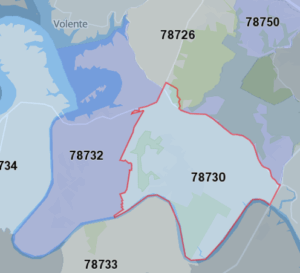Expert says traffic won’t deter area real estate
By LESLEE BASSMAN, Four Points News

Four Points is comprised of: 78730 including River Place, Westminster Glen, Glenlake, Long Canyon, etc.; 78732 including Steiner Ranch, Comanche Trail, Strawberry Hill, etc.; and 78726 including Grandview Hills and other neighborhoods along RM 620. 78726 statistics in this report include areas north of Four Points.
Source: United States Zip Codes
Austin’s residential real estate market continues to be strong and that includes the Four Points area, according to experts.
The area’s “declining inventory and robust sales trends are creating an increasingly competitive housing market across all price classes,” according to the Austin Board of Realtors May report which reflects home sales and inventory in the Austin-Round Rock housing market.
“We’re seeing tremendous growth this year in Austin, much to my surprise,” said Mark Sprague, state director of information capital for Independence Title. “As a general market, we are seeing double the number of residential listings, double the number of commercial listings and sales (as compared to the previous years). Four Points is no different from that.”
In the Four Points area — ZIP codes 78730, 78732 and 78726 — single-family home sales in 78730 saw the greatest percentage growth at 56.5 percent year-over-year from January-April 2017-18, ABOR’s records reflect.
Similarly, 78730 — which includes River Place, Westminster Glen and Long Canyon — gained a 74.6 percent year-over-year increase in single-family home sales dollar volume, the most out of the area’s three local ZIP codes as well as the largest year-over-year increase, at almost 30 percent, in the median price of its single-family homes. In April, the median price for home in 78730 was $857,500, ABOR statistics show.
The Steiner Ranch, Comanche Trail and Strawberry Hill 78732 ZIP code saw about a 20 percent increase year-over-year in both its single-family home sales and single-family home sales dollar volume, according to ABOR. The median price for homes in 78732 in April was $499,900, an 8.7 percent growth from April 2017, ABOR statistics show.
The Grandview ZIP code 78726 came in last out of the local three ZIP codes.
Traffic factor
Sprague acknowledges that, while traffic on RM 620 in Four Points is an issue for residents along the route, the issue will not stop outsiders from relocating to the area.
“When we look at CEOs looking to move, traffic is 87th on the list of concerns,” Sprague said. “All traffic is relative to where you are moving from, whether it’s L.A. or whether it’s Dallas or whether it’s Alvin, Tex. Although traffic is an issue for those who live (in Four Points), it’s a non issue for companies moving here.”
Sprague said he noticed a trend with corporate recruiters for Austin companies recently — paperwork for potential employees includes a choice of whether the candidate would prefer a Downtown Austin or North Austin location.
“(Four Points is) pretty well built out so traffic is going to remain the same,” Sprague said. “The problem with traffic in Austin is you can’t (expand your roadways) wider and you can’t go up. I don’t see that changing.”
Sprague said lake living or the lake lifestyle is still desirable and, even with traffic, he said he does not anticipate residential sales in the area “slowing down anytime soon.”
“When somebody says, ‘traffic’s going to kill us,’ I (say), ‘individually I agree with you (and) emotionally I agree with you,’” Sprague said. “However, that’s not what the numbers show.”
ABOR president Steve Crorey said that historically, Four Points is following the general Austin trend.
“Since 2011, sales in the Four Points area have generally followed the same trend we see in the Austin-Round Rock MSA: lack of inventory and increasing prices,” he said.
The zip codes of 78726 and 78732, which encompass The Parke and Steiner neighborhoods, have seen a median price increase from roughly $350,000 in 2011 to $500,000 in April, Crorey said.
In the 78730 area, which generally follows RM 2222, including River Place, the median price increased from $590,000 in 2011 to about $800,000 in April 2018, Crorey said.
“It’s important to note that the median selling price is usually lower than the average selling price, as it represents the mid point where exactly half of the homes listed are above and half of the homes are below,” he added.
Greater Austin
In comparison, sales of single-family homes in Austin in April increased 7.4 percent year-over-year to 859 home sales, ABOR’s records reflect. New listings and pending sales within the Austin-Round Rock metropolitan statistical area have increased year-over-year although the number of active listings decreased 2.8 percent, ABOR’s report states
Conditions show — at least across Travis and Williamson counties — single-family homes sales continue to increase, with “low inventory but steady demand,” the report states. Within Travis County, housing inventory decreased in April from 0.3 months to 2.3 months, according to ABOR.

